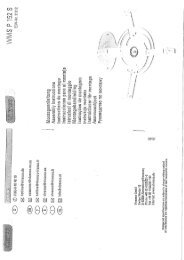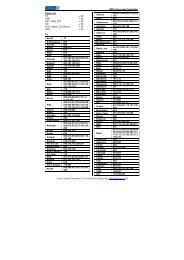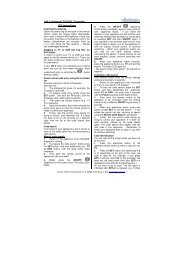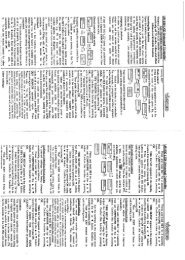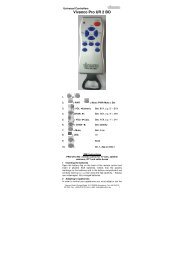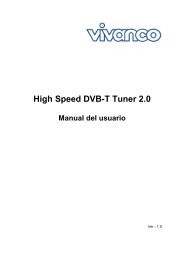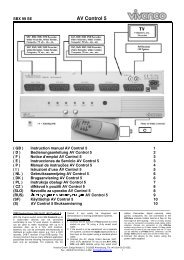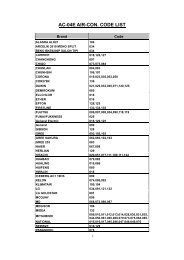computer
computer
computer
You also want an ePaper? Increase the reach of your titles
YUMPU automatically turns print PDFs into web optimized ePapers that Google loves.
144<br />
ADR<br />
ASTRA Digital Radio. A transmission system that uses ASTRA to transmit twelve stereo radio<br />
programmes in Hi-Fi quality on a single audio sub-carrier of a TV transponder.<br />
Attenuation<br />
Loss of signal strength, normally expressed in decibels. Attenuation can occur in the connection<br />
cables between the antenna and receiver. It can also be due to the distance between the transmission<br />
antenna and the receiver antenna.<br />
AV<br />
Shorthand for a button, connection plug or an operating mode to activate or connect audio-visual<br />
equipment. The AV connection, e.g. between receiver and TV equipment is normally produced as a<br />
Scart cable and provides better quality than an antenna cable.<br />
Azimuth<br />
From the position of the observer the skywards direction (east/west) of the satellite.<br />
Band<br />
Band defines a range of frequencies between two values set according to technical agreement.<br />
Bandwidth<br />
Expression for a series of frequencies, covered by a particular band.<br />
Bearer<br />
Very high-frequency oscillation that due to modulation can carry a radio, or TV signal over great<br />
distances. The frequency of the oscillation is also the bearer frequency. A TV satellite transmissions,<br />
for each television channel there is an image or visual bearer and one or more audio bearers.<br />
Bowl<br />
Jargon expression for the parabolic reflector.<br />
Broadcasting range<br />
The interval between two frequencies that define a band. In satellite receivers it shows the frequency<br />
range in which you can operate without distortion or error.<br />
CATV<br />
Community Antenna TV. Shorthand for a cable TV signal distribution system<br />
Channel<br />
Part of frequency band allocated according to an agreed allocation procedure. A TV channel consists<br />
of two frequencies, one for the visual and one for the audio content. Every channel is identified by<br />
numerical code (except for the European television channels broadcast on the 40-230 MHz frequency<br />
band, which are identified by a letter code).<br />
Co-ax cable<br />
An item to provide the electrical connection between antenna and receiver. It consists of a special<br />
cable, which has an inner and an outer core. Each is separated by insulating material, to guarantee<br />
minimum signal loss. Co-ax cable is also called shielded cable because the outer core also protects<br />
the inner core from outside interference, thereby minimising the signal loss in the inner core.<br />
Conditional Access System (CA)<br />
To unlock a coded programme, the so-called Conditional Access Module (CAM) is required. The<br />
interfaces for the CA modules are internationally standard. From this came the Common Interface. So<br />
that the digital receiver can accept various CAMs, it has one or more interfaces with the Common<br />
nterface Standard. This CI interface provides the necessary to security for the future for later expansion<br />
of the digital receiver. There are CA modules not only for play-programmes, but also for other<br />
applications such as memory cards or modems<br />
Control signal (22 kHz)<br />
This means a low-frequency signal around 22 kHz with which the satellite receiver provides an<br />
additional switching capability for the LNB / LNBs. If the signal is switched on or off, it is possible to<br />
choose between several antennas via a box connected between the two.<br />
Converter<br />
The receiver unit at the focal point of the parabolic antenna, to convert from the frequency range of<br />
the satellite to the intermediate frequency of the receiver.<br />
dB<br />
Decibel A unit of measurement to express the relationship between values of the same type. It is often<br />
used to express the attenuation of a cable or distance, or the output of an amplifier.<br />
Decoder<br />
Equipment to unlock a coded transmission. Each encoding system has an equivalent decoder. A<br />
decoder can also be used to change one format into another (e.g. D2-MAC to PAL).<br />
Demodulator<br />
The circuit in a satellite receiver, the purpose of which is to filter out the audio and video content from<br />
the bearer signal of a TV channel.<br />
GLOSSARY<br />
“Little SAT lexicon”<br />
Digital<br />
And electronic method to process pictures and sounds. It is based on the conversion of picture and<br />
sound signals into binary values Digital technology is less prone to interference and the signal quality<br />
is higher. Digital audio is already available on CD, DCC, Minidisc, DAT, ADR, etc. Digital video is<br />
available on the MPEG system.<br />
DiSEqC<br />
Digital Satellite Equipment Control – Digital control instructions to reach further stations except for H/V<br />
and 22 kHz.<br />
Dolby Prologic<br />
A system similar to Dolby Surround. The technique of digital delay is used to achieve much greater<br />
dynamic performance of the main channel, or to assign the voice channel to it, whilst directing special<br />
effects to the other four speakers.<br />
Dolby Surround<br />
A system for the processing of audio information in films, television films and video clips. This system<br />
enables the viewer to be acoustically involved in what is going on. The audio environment is artificially<br />
reconstructed, so that the classic stereo channels (front right and front left) have three sound sources<br />
added: the main channel as well as right rear and left rear channels.<br />
Dual Feed<br />
The system for receiving two satellites with a single antenna. The basic requirement for this system is,<br />
that the satellites are not more than 9° apart. The system is mainly used for receiving ASTRA 19.2°<br />
East und EUTELSAT 13° East.<br />
DVB<br />
Digital Video Broadcasting. Digital broadcast standard of TV signals in accordance with the MPEG<br />
standard. These techniques are providing impetus to the various European broadcasters, as far as the<br />
transmission of digital TV signals is concerned.<br />
Elevation<br />
The term elevation refers to the vertical angle at which the antenna must be positioned to be able to<br />
see” the satellite required. Azimuth, therefore, is the horizontal angle. Elevation the vertical angle -<br />
when this is being set the satellite must be “seen”.<br />
EPG<br />
EPG means Electronic Programme Guide and is an electronic programme magazine that is transmitted<br />
with the programmes. The necessary data can easily be obtained from the data stream transmission<br />
of a programme or bouquet satellite. The EPG data supplied by the programme provider must of<br />
course be readable and processable by the DVB receiver. This takes place via the so-called<br />
Application Programming Interface (API).<br />
FM<br />
Frequency modulation. A method of modulation whereby the input signal varies the frequency of the<br />
carrier wave.<br />
Footprint<br />
The area of the earth's surface covered by the beam from a satellite repeater. It refers to the<br />
geographical area in which the particular TV or radio programme can be received. The footprint can<br />
be represented graphically as a series of more or less concentric circles, each of which has a<br />
transmission capacity expressed in dBW. Often, as an alternative the antenna size required within the<br />
circle is shown.<br />
Frequency<br />
A unit of measurement for the number of complete oscillations per second, expressed as oscillations<br />
per second, or Hertz (Hz). Therefore, 950 MHz is equivalent to 950 million oscillations per second.<br />
Gain<br />
A unit of measurement, expressed in decibels, to define the amplification capacity of a parabolic<br />
antenna or amplifier. Gain is the opposite of attenuation. The gain of an antenna depends on the<br />
diameter of the parabolic reflector and its efficiency.<br />
Geo-stationary<br />
Geostationary describes objects above the equator that are moving at the same speed as the rotation<br />
of the earth. From the position of the observer they appear to be stationary<br />
HDTV<br />
High Definition Television, or high-resolution television. This system has been tested by broadcasting<br />
the most important sporting events. The main characteristics of HDTV are: wide-screen format (16:09),<br />
double the number of screen lines (from currently 625 to 1250) and digital audio quality.<br />
Latitude<br />
The separation expressed in degrees of a particular spot on the surface of the earth and the equator.<br />
The corresponding value can be obtained from geographical charts. It is important for the calculation<br />
of the elevation and declination when erecting a fixed or moveable antenna.



